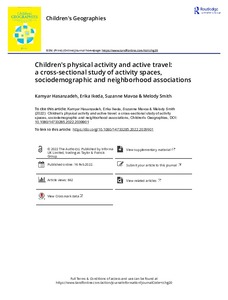Children's physical activity and active travel: a cross-sectional study of activity spaces, sociodemographic and neighborhood associations
Hasanzadeh Kamyar; Ikeda Erika; Mavoa Suzanne; Smith Melody
Children's physical activity and active travel: a cross-sectional study of activity spaces, sociodemographic and neighborhood associations
Hasanzadeh Kamyar
Ikeda Erika
Mavoa Suzanne
Smith Melody
ROUTLEDGE JOURNALS, TAYLOR & FRANCIS LTD
Julkaisun pysyvä osoite on:
https://urn.fi/URN:NBN:fi-fe2022081154379
https://urn.fi/URN:NBN:fi-fe2022081154379
Tiivistelmä
Measures of individual mobility, such as activity space, have been previously used to help improve our understanding of individuals' interactions with their everyday environments. However, such methods have rarely been adopted in studying children's physical activity and active travel behavior. In this study, we use a combination of participatory mapping and accelerometer data collected from children aged 8-13 years living in Tamaki Makaurau/Auckland, Aotearoa/New Zealand, to describe children's travel behavior and explore associations of active travel, physical activity, and socio-demographic characteristics with environmental attributes. The results from this study reveal complex associations between these different layers. Density of cycling routes was consistently associated with higher levels of physical activity captured via moderate-to-vigorous physical activity (MVPA), prevalence of active travel, and total activity space exposure. Nevertheless, population density, greenspace, and land-use mix revealed varying associations across different activity behaviors including MVPA, number of steps, and prevalence of active travel. The results from this study not only reassert the complexity of person-environment relationships, but also highlight the potential impacts of measurement and analytical methods on the study results. The novel combination of participatory mapping and accelerometer data together with activity space analysis provided new analytical insights which we discuss in this paper. This study concludes by reporting its observations and envisioning future research directions.
Kokoelmat
- Rinnakkaistallenteet [27094]
